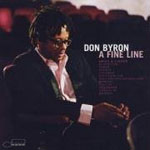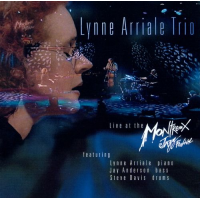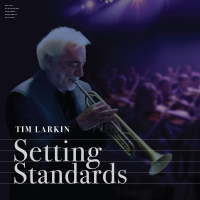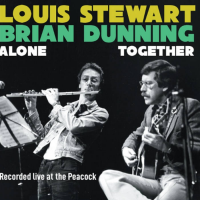Home » Jazz Articles » Album Review » Don Byron: A Fine Line: Arias & Lieder
Don Byron: A Fine Line: Arias & Lieder
Even as he completes one project, he's working on the next one, which inevitably will be a departure from all of the CDs that precede it. Yet, each of Byron's CD's enlarge not only the body of his work, but also the fullness of his musical perspective.
Possessing interests in jazz, classical works, pop, klezmer, country/western, funk, theatrical repertoire, rap and Latin music, Byron's background is such that his curiosity about various forms can take any direction in future productions. While many jazz artists remain consistent and predictable, Byron naturally and without pretense investigates approaches that few other jazz musicians would attempt.
Plus, Byron's dedication to the revival of the jazz clarinet remains admirable, extending the tradition through an original aesthetic, or perhaps a through an imaginative synthesis, that positions a clarinetist as the creative leader of advances in music, and indeed African-American culture.
Thus, no one except perhaps Byron' producer Hans Wendl knows where Byron will go next. This unpredictability leads to one inevitability: that Byron'CD's always will present a thematic concept, complete with detailed musical proof of his hypotheses.
Byron recorded the music of Mickey Katz not because it would become the flavor of the month, but because he believes in the excellence of the klezmer music that had been overlooked. He brought together modern poetry and rap on Nu Blaxploitation because it asserts a statement about African-American culture that mainstream culture didn't hear—as did Tuskegee Experiments. Music For Six Musicians threw out the common view of Afro-Caribbean music as consisting of a regular beat more akin to jazz and introduced the more authentic clavé that Byron heard in his Bronx boyhood neighborhood and in Boston where he played in Latin bands while attending Berklee. Romance With The Unseen assumed an intellectual basis for the notion of "romance" and associated with it anger, longing and unity.
So where is Don Byron going with A Fine Line: Arias & Lieder?
Byron'contention this time is that, even though modern music has advanced to the point of non-singability, African-influenced musical concepts have tethered songs to the tradition of the more classical arias of opera and lieder of composers like Schumann. Once again, Byron has recorded a thematic album that posits an idea and then makes his point through example.
The listener, then, may be taken aback by the proximity of Bernstein's operatic aria of "Glitter And Be Gay" two tracks away from Roy Orbison's "It's Over." In fact, Byron'choice of singers (who have collaborated in the past with pianist Uri Caine as well) is apt. Patricia O'Callaghan seems to be a student not of genre, but of voice, as she exhibits chameleonic versatility by sounding like two distinctively different singers on her extroverted rendition of "Glitter And Be Gay" and then her soft and subtle performance of Stevie Wonder's "Creepin." Singer Mark Ledford proves to be just as versatile, wordlessly singing the melodic lines of Ornette Coleman's "Check Up" in unison with Byron and then lowering his voice an octave in a range closer to Byron's bass clarinet on "It's Over."
The one track involving Cassandra Wilson, Stephen Sondheim's "The Ladies Who Lunch," is notable for the fact that it leads the listener to realize the natural next step in her career: the Broadway theater. She is unexpectedly effective in presenting the story-telling nature of the tune, complete with narrative, rhetorical questions, humor and anecdotal descriptions.
So where does all of this leave Byron, the intellectual center of the album? Giving Henry Mancini due respect for his unparalleled talent for tunesmithing, Byron is reduced to playing above the background singers on "Soldier In The Rain" after introducing the melody. And how do you work a clarinet into the overwrought tune, "It's Over"?
Rather than taking center stage in the vocal numbers, Byron alternates the sung "arias und lieder" with compare-and-contrast clarineting of classical compositions like Puccini's "Nessun Dorma" or Chopin's "Larghetto." Byron has composed one minor-keyed étude, "Basquiat," that he performs in duo with Caine.
As usual, Don Byron is uncompromising, thought-provoking and controversial on A Fine Line: Arias & Lieder. Some listeners, especially those who have followed Caine's just-as-challenging work, will endorse it. Some, with demands for consistency and most easily digestible musical consumption, will argue against it.
But once again, no one will be neutral about Don Byron's music.
Track Listing
Check Up; Zwielicht; Glitter And Be Gay Basquiat; It's Over; Creepin'; Nessun Dorma; Soldier In The Rain; Reach Out I'll Be There; The Ladies Who Do Lunch; Larghetto.
Personnel
Don Byron
clarinetDon Byron: clarinet, bass clarinet; Uri Caine: piano; Jerome Harris: bass guitar, acoustic guitar; Paulo Braga: drums, percussion; Mark Ledford, Patricia O'Callaghan, Dean Bowman, Cassandra Wilson: vocals.
Album information
Title: A Fine Line: Arias & Lieder | Year Released: 2000 | Record Label: Blue Note Records
Tags
PREVIOUS / NEXT
Support All About Jazz
 All About Jazz has been a pillar of jazz since 1995, championing it as an art form and, more importantly, supporting the musicians who make it. Our enduring commitment has made "AAJ" one of the most culturally important websites of its kind, read by hundreds of thousands of fans, musicians and industry figures every month.
All About Jazz has been a pillar of jazz since 1995, championing it as an art form and, more importantly, supporting the musicians who make it. Our enduring commitment has made "AAJ" one of the most culturally important websites of its kind, read by hundreds of thousands of fans, musicians and industry figures every month.

























